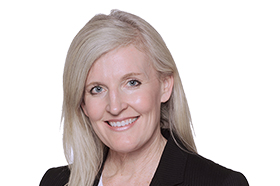Meteorologists need to consider a complex landscape of emerging trends, local terrain, recent changes, and historical data to create a forecast of the future. To forecast the future in today’s technology companies, leaders need data and insight from financial planning and analysis (FP&A).
Tech companies can experience rapid growth or decline, high turnover, and fierce competition. That makes it difficult to know what’s coming. Solid assumptions are the fundamental reference points for an engaging and decisive company outlook.
FP&A needs to help leaders connect their past performance to their anticipated results. To map that connection, companies need to turn evidence into conclusions.
“The challenge for many tech companies is trying to forecast what the go-forward operations will be like,” said Grant Thornton Technology Industry National Managing Partner Andrea Schulz. “You need to show precision when you're talking with potential acquirers or investors about the information that is actually underlying the forecast. You need to have confidence in the data behind it, and confidence that you've been informed about the future appropriately.” Assumptions need to be thoroughly explained and justified, to prove where the company will go.
International Business Report: The US mid-market
Data from Grant Thornton International’s International Business Report shows optimism in the US middle market is up sharply. Find out what’s next.
Insights on FP&A in other industries
ARTICLE
ARTICLE
ARTICLE
ARTICLE
Investors need proof
In our Tech CFO survey, 65% of finance leaders said they will need to raise capital in the next 12 months, and 91% sometime in the next two years.
“Investors have demanded that tech companies demonstrate a path to either profitability or greater profitability,” Schulz said.
To build proof and establish trust, a company’s FP&A team needs to provide solid data and assumptions that look at both internal and external factors. “Look out ahead, at what's happening in the economy and the market — changes and seasonality within the industry,” said Grant Thornton CFO Advisory Market Managing Partner Lisa Heacock. “Combine that with past trends, year over year, quarter over quarter, to help ensure you're accurately forecasting. You have to take all of the external factors into account, as well as internal factors.”
For many tech companies, internal factors have recently changed. “Many companies have recently gone through reductions in force, right-sizing their organization to show more operational excellence,” Schulz said. “So, some of the past patterns or financial results might not be as predictive of the future.”

“I’ve been spending time with the procurement function to understand how to better allocate and optimize our investments.”
Some companies have been developed new efficiencies that could affect their future performance. “I’ve been spending time with the procurement function to understand how to better allocate and optimize our investments,” said Qualys CFO Joo Mi Kim during a recent Grant Thornton webcast. “We are performing an in-depth analysis of third-party vendors to identify cost savings by asking ourselves some questions. ‘What are the pros and cons of switching vendors? What is the ROI over the next couple of years?’”
To show investors the updated proof they demand, tech companies need to make sure their forecasts are current and data-driven. “You see a lot of tech companies re-forecasting on a quarterly basis,” Schulz said. “You need to show what information is actually underlying the forecast. Retain a repository of that information and the underlying assumptions that built the forecast, so that a third party can stress-test it.”
The underlying data is especially important as tech companies shift from projecting cuts and cost savings to growth. “Now that companies have gained operational efficiencies, they’re looking at where they can grow,” Schulz added. “It's not only how to control costs. It's showing projections for top-line growth at this point in time.”
To generate updated data-driven forecasts with efficiency, FP&A teams need dynamic tools.
Insights on other issues in the tech industry
SURVEY REPORT
ARTICLE
ARTICLE
ARTICLE
ARTICLE
Get tools to show dynamic results
“It's important that you can pivot very quickly on your forecast, and you can make it dynamic,” emphasized Heacock. “You need to have a software tool, versus just a spreadsheet where there could be a lot of mistakes and errors.”
“Many FP&A departments end up forecasting through spreadsheets, and that's where you’re at a significant disadvantage,” Schulz pointed out. “That is additional lag time, when you're talking about doing refreshes, because you're having to aggregate information from disconnected sources. Try to bring together a solution that's automated, quick to refresh, connected to the other systems in your tech stack. Ultimately, that's where you really start to get an advantage.”
Dynamic solutions for FP&A don’t have to be part of a large enterprise investment. “Often, people immediately think of these large enterprise solutions,” Schulz said. “I'm not necessarily talking about a robust enterprise-wide build out — there's a whole suite of SaaS offerings out there to enable more automated solutions. These are FP&A tools where a company doesn't need to have a significant implementation, but it gets them moving out of that spreadsheet FP&A drudgery.”
“Ultimately, it's not necessarily the biggest and most known solution — it’s the one that scales with your organization appropriately,” Schulz added. “You have to look at the implementation time, the training requirements, and how much of a lift it is to actually use it and make it be functional. For mid-market tech companies, it's important to really assess the tool based on your scale and where you see yourself growing eventually.”
“It's really important to nail down the requirements — which is not entirely an IT function, it's also a business function,” Heacock said. “You need to understand the current and future strategy of the company, to make sure you set it up appropriately. What type of reporting and information do you need, to manage the business? What does the business structure look like? What are the segments? When selecting software, it’s important to select the best fit based on requirements that will work “now” and in the future based on the growth strategy.”
The wrong solution can wind up being no solution at all. “I've seen it a lot of times — if you don't set it up well, people tend to go back to the spreadsheets,” Heacock said.
Analyze your results
A centralized FP&A solution can also help a tech company compare data trends over time and derive conclusive results. “Make sure that you're looking back to see: How well did I forecast? How did the forecast compare to actuals? How do actuals compare to the original budget, or why was I off, so that I can make the forecast better in the future?” Heacock said.
“If you have a smaller company, where the same people focused on closing the books are completing the FP&A function, they might spend all month closing the books,” Heacock said. “That leads to more issues, because there's not enough time for analysis.”
“That happens a lot, especially if a company uses spreadsheets for budgeting and forecasting — a lot of times they're not able to get through and actually do analysis, so they miss things. They're going to mis-forecast,” Heacock said. “If there's a dedicated team focused on analysis, even just comparing and analyzing different trends, that is key. It helps you build in better assumptions, so you have a better, more solid, forecast.”
In tech companies that are seeking capital, FP&A can be the core of a quality forecast. As tech companies move into the future and begin to look at IPO again, forecasts will meet even greater scrutiny.
Get ready for an even closer look
The IPO market has not returned. But it will, and FP&A will be central to each company’s burden of proof. “I've actually watched FP&A derail an IPO, because their inability to forecast,” Schulz said. “If you can't demonstrate to bankers that you have that discipline, and you know where your business is going, you can't sell that to the market. You have to be able to tell your story when you're on the road show, to convince other investors they should be involved in your company.”
IPO might not be on your current map, but now could be the time to prepare. “If you’re not able to hit your mark when you're a private company, and not subject to the view of the capital markets, that doesn't bode well,” Schulz said.
“I've been advising companies to get that pattern recognition under the belt now, hone your forecasting skills, develop your story, start to build that structure. Many later-stage companies are going to need to show that discipline when the road show comes,” Schulz said. “That's going to be compelling, and it will all fold into their growth story, to really show the public markets that they are worthy of entering through an IPO.”
Tech companies might be seeking capital now or forecasting farther out, but they need to start building profitability projections with a pattern of accuracy and FP&A insight. “Whether it's venture capital or private equity investors, or even a potential acquirer looking at the company, they’ll look at the history and discipline around the company’s forecasting, and whether they've been on target — it’s a discussion about the accuracy of your historical results,” Schulz said.
Contacts:



Andrea Schulz
National Managing Principal, Technology Industry,
Grant Thornton Advisors LLC
Partner, Audit Services, Grant Thornton LLP
Andrea Schulz serves as Grant Thornton’s national managing partner for Technology. In this role, she oversees the growth and operations of the firm’s Technology industry practice, which encompasses a full range of audit, tax and advisory services.
San Jose, California
Industries
- Technology, media & telecommunications
Service Experience
- Audit & Assurance
Insights on FP&A in other industries
Our technology and telecommunications featured industry insights

No Results Found. Please search again using different keywords and/or filters.






Share with your network
Share